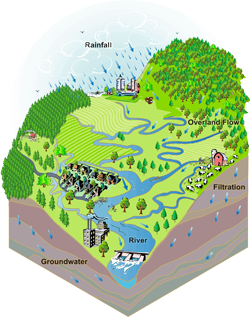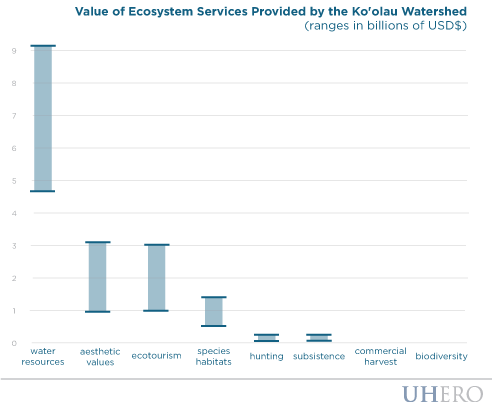Over the years, the term “watershed” has evolved from signifying the divide separating one drainage basin from another to the drainage basin itself. A drainage basin or catchment area is a section of land drained by a river and all of its tributaries. Watersheds come in all shapes and sizes, and the U.S. Environmental Protection Agency estimates that there are 2,267 watersheds in the United States and Puerto Rico alone. In Hawai‘i, much of the water captured in our watersheds eventually drains into subsurface groundwater aquifers.

Watershed conservation activities (e.g. feral animal control, non-native weed control, native reforestation) can increase the amount of water captured as groundwater recharge, which is especially important given that groundwater provides 99 percent of Hawaii’s domestic drinking water. The benefit of a healthy watershed becomes even clearer when one considers the increasing trend in water scarcity owing to a growing population, rising per capita income, and climate change. Ecosystem services generated by a watershed area extend well beyond groundwater recharge provision, however.
A previous UHERO study estimates that the present value of ecosystem services generated by natural capital embodied in the Ko‘olau Watershed is in the range of $7.4-14.0 billion, assuming that the state of the watershed remains at the status quo and groundwater is optimally managed. While the benefits associated with water resources ($4.7-9.2 billion) are by far the largest, a variety of other ecosystem services also generate substantial value: species habitats ($0.5-1.4 billion), biodiversity ($0.7-5.5 million), subsistence ($34.7-131 million), hunting ($62.8-237 million), aesthetic values ($1-3.1 billion), commercial harvest ($0.6-2.4 million), and ecotourism ($1-3.0 billion). Other services which are difficult or impossible to quantify, such as cultural importance, increase the total value further.

– Chris Wada